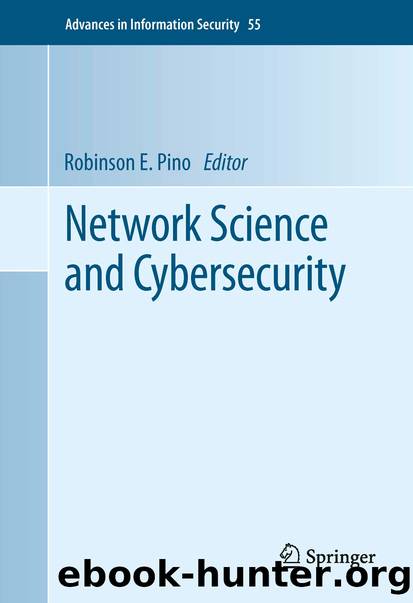Network Science and Cybersecurity by Robinson E. Pino

Author:Robinson E. Pino
Language: eng
Format: epub
Publisher: Springer New York, New York, NY
3.2 Hybrid Designs
Many of the new nano-enabled technologies are not strictly compatible within current CMOS fabrication lines. They require front-of-line or back-of-line processing and often have special packaging needs. Great effort is underway, however, to bring these capabilities into mainstream fabrication lines.
Memristors for example, take numerous forms of construction based on a variety of technologies, including resistive random access memory (ReRAM), phase change RAM (PCRAM), magnetoresistive RAM (MRAM), and spin-transfer torque MRAM (SST-RAM). Thus, a wide range of performance characteristics can be achieved using varied material and architectural designs, all demonstrating the characteristic pinched I-V hysteresis and non-volatility. Such variety makes standardization slow, but gives neuromorphic circuit designers expanded fabrication options.
There are two critical tasks for successful memristive device integration with CMOS: manufacturability and usability. Concerning the former, the devices to be used must consist of materials that are permitted inside a CMOS foundry, which further restricts the materials allowed in the front end of line (FEOL) as compared to the back end of line (BEOL). All the processing steps needed to make the devices’ structure must be scalable to fabricate devices en masse. Lastly, all of the devices must be functionally identical (though some applications may actually exploit device non-uniformities). Part of the difficulty of manufacturing memristive devices is that the physics of device switching is not well understood at nanometer size scales. In particular, ReRAM (of which PCRAM is a subset) may be composed of binary metal oxides, chalcogenides, or perovskites, among other materials, and switch due to filament formation, vacancy migration, phase change, or other processes [10]. At these scales, small variations in the device size or material composition often have large effects upon subsequent device switching parameters.
However, because of this variety of materials and mechanisms, different device resistance values, switching voltages, and switching times are available to the circuit designer. When considering the appropriate device metrics of reliability and endurance that must be attained, one must first consider the intended use of the device. For von Neumann computing applications, if these devices are to replace Flash or SRAM, then endurance cycles of about 106 and write speeds of a couple tens of nanoseconds must be achieved, respectively. Even if memristive devices cannot meet these requirements, SWAP savings may still be achieved by strategically replacing some transistors in a circuit. For devices used in neuromorphic applications, the range of addressable resistance values and the operative voltages will be more critical than the write speed. Because of these varied ends, there will likely be a variety of memristive device “flavors” available to the circuit designer in the future.
Download
This site does not store any files on its server. We only index and link to content provided by other sites. Please contact the content providers to delete copyright contents if any and email us, we'll remove relevant links or contents immediately.
Grails in Action by Glen Smith Peter Ledbrook(9163)
Sass and Compass in Action by Wynn Netherland Nathan Weizenbaum Chris Eppstein Brandon Mathis(8808)
Azure Containers Explained by Wesley Haakman & Richard Hooper(7438)
Configuring Windows Server Hybrid Advanced Services Exam Ref AZ-801 by Chris Gill(7431)
Kotlin in Action by Dmitry Jemerov(7263)
Running Windows Containers on AWS by Marcio Morales(6979)
Microsoft 365 Identity and Services Exam Guide MS-100 by Aaron Guilmette(5398)
Microsoft Cybersecurity Architect Exam Ref SC-100 by Dwayne Natwick(5208)
Combating Crime on the Dark Web by Nearchos Nearchou(4978)
The Ruby Workshop by Akshat Paul Peter Philips Dániel Szabó and Cheyne Wallace(4667)
Management Strategies for the Cloud Revolution: How Cloud Computing Is Transforming Business and Why You Can't Afford to Be Left Behind by Charles Babcock(4527)
Python for Security and Networking - Third Edition by José Manuel Ortega(4232)
The Age of Surveillance Capitalism by Shoshana Zuboff(4209)
Learn Wireshark by Lisa Bock(4114)
The Ultimate Docker Container Book by Schenker Gabriel N.;(3885)
Learn Windows PowerShell in a Month of Lunches by Don Jones(3681)
DevSecOps in Practice with VMware Tanzu by Parth Pandit & Robert Hardt(3565)
Windows Ransomware Detection and Protection by Marius Sandbu(3540)
Blockchain Basics by Daniel Drescher(3507)
